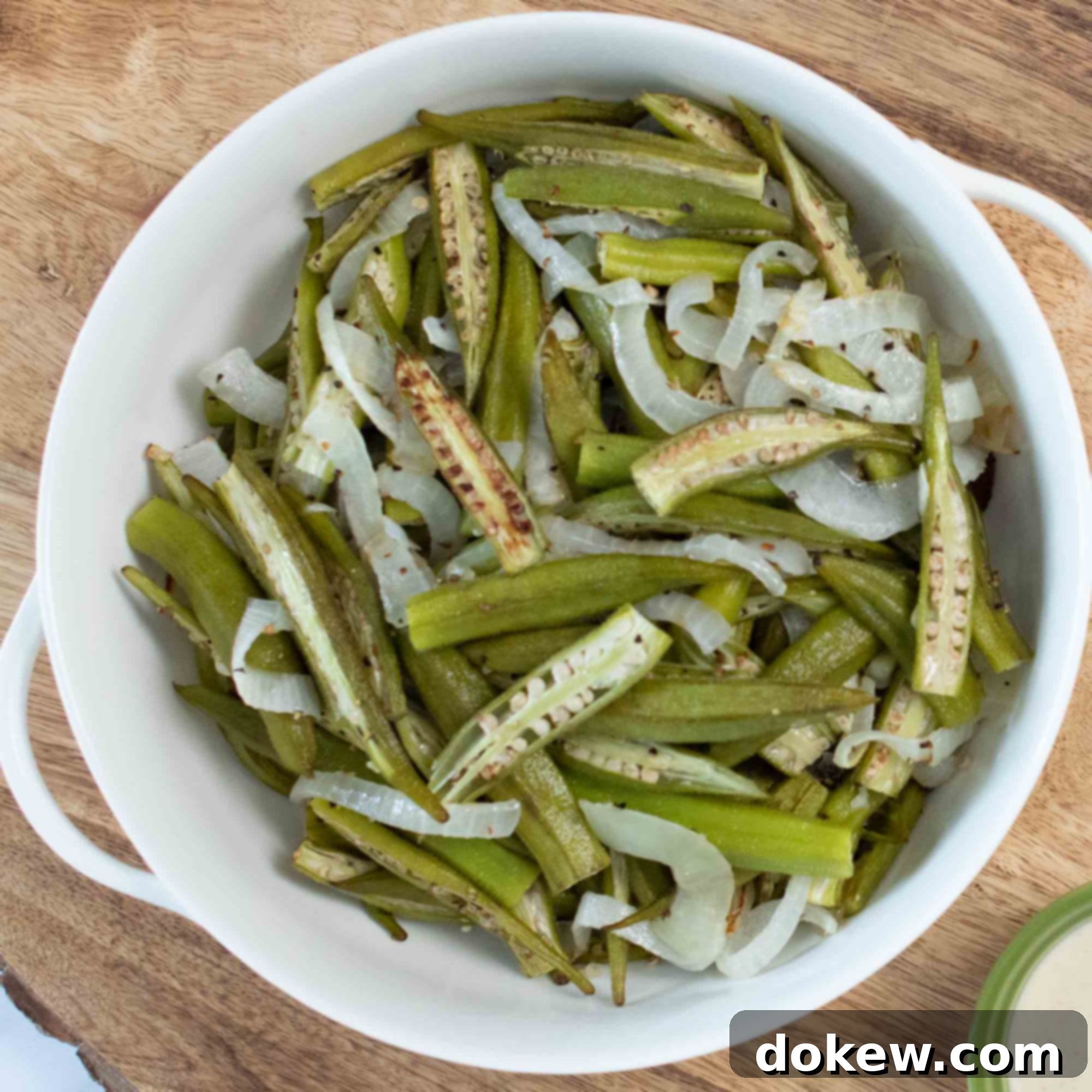Sweet & Savory Roasted Okra and Onions: Your New Favorite Easy Side Dish
Discover the delightful transformation of okra and onions when roasted to perfection! This incredibly easy, one-pan side dish brings out the natural sweetness of both vegetables, caramelizing them into a tender, flavorful treat. It’s the ideal recipe for anyone new to okra, or even those who’ve been hesitant to try it, promising a pleasant surprise with its sweet, non-slimy texture. Our simple roasting method, utilizing parchment paper, not only ensures a perfect cook but also means virtually no cleanup – a true weeknight dinner hero that makes healthy eating effortless.
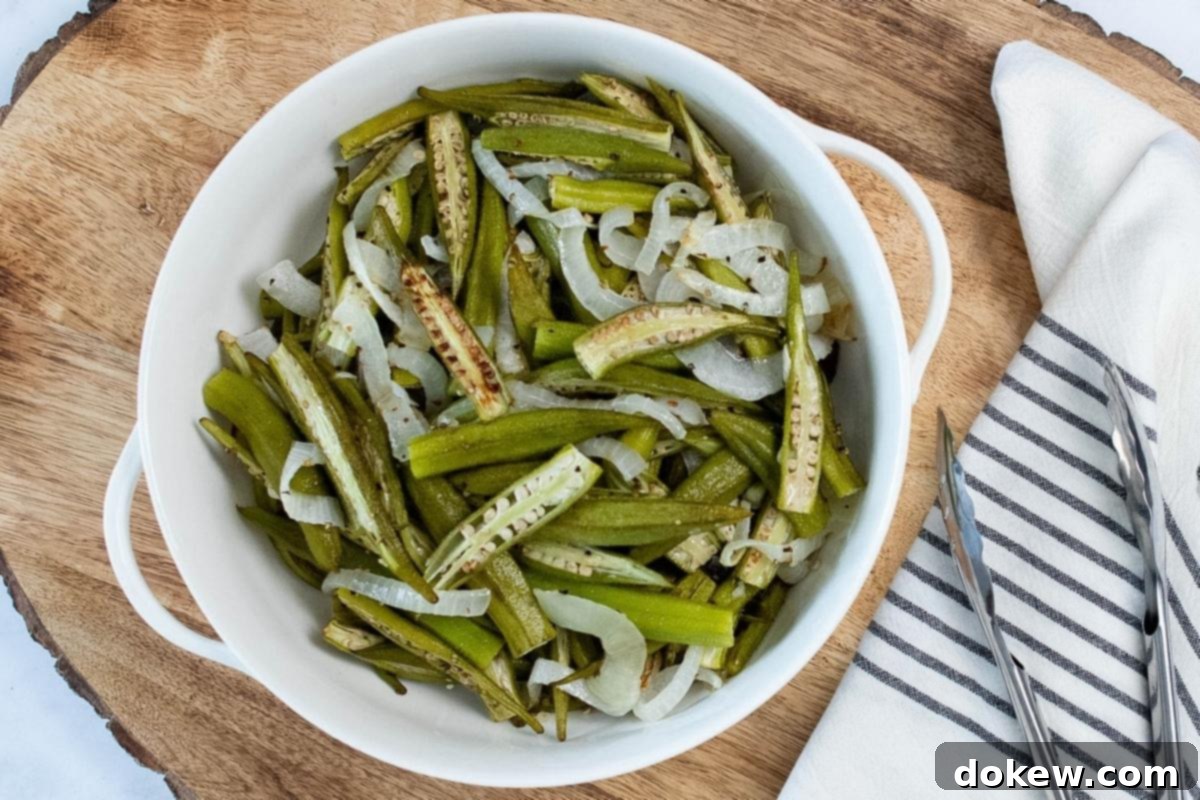
Roasted Okra and Onions offers a versatile flavor profile that complements a wide array of main courses. The inherent sweetness, savory notes, and slightly crisp texture make it an excellent accompaniment to both light and hearty meals. We particularly love pairing it with comforting and flavorful dishes like Slow Cooker Cranberry Chicken, where its vibrant taste and slight char cut beautifully through the richness of the chicken and sauce. It also shines alongside pasta dishes such as Chicken Pepper Pasta, adding a fresh, roasted vegetable component that elevates the entire meal. For meat lovers, this side dish is a fantastic match for robust entrées like London Broil, providing a light yet satisfying contrast to the savory beef. Furthermore, it beautifully enhances classic comfort foods like Cubed Steak and Gravy or Mushroom Salisbury Steak, bringing a touch of natural sweetness and an appealing texture that transforms a simple dinner into something special.
[feast_advanced_jump_to]
Essential Ingredients for Perfect Roasted Okra and Onions
Crafting this simple yet profoundly flavorful side dish requires just a handful of fresh, quality ingredients. The beauty of this recipe lies in its minimalism, allowing the natural tastes of the vegetables to truly shine through. Here’s a closer look at what you’ll need:
- Fresh Okra: This often-misunderstood vegetable is the star of our recipe. When exposed to high, dry heat during roasting, okra undergoes a remarkable transformation. It loses its characteristic sliminess, developing a delightful sweetness and a tender-crisp texture. Choosing small, firm, and bright green pods will ensure the best flavor and texture in your final dish.
- Onion: A large yellow onion is our preferred choice for this recipe due to its balanced flavor profile. Yellow onions offer a gentle sweetness and a subtle pungency that mellows and intensifies beautifully during roasting. As they caramelize alongside the okra, they contribute a rich, savory depth and another layer of sweetness that perfectly complements the dish.
- Salt & Pepper: These fundamental seasonings are crucial for enhancing the natural flavors of the okra and onions. A good quality sea salt or kosher salt will draw out moisture and season evenly, while freshly ground black pepper adds a fragrant, earthy warmth. Adjusting the amounts to your personal taste is key to achieving a perfectly seasoned result.
- Vegetable Oil (or Olive Oil): A neutral-flavored vegetable oil, or a good quality olive oil, is essential for promoting even roasting and beautiful caramelization. The oil helps to coat the vegetables uniformly, ensuring that the seasonings adhere properly and that the okra and onions achieve that desired golden-brown, slightly crispy exterior without sticking to the pan. Avocado oil or grapeseed oil also work wonderfully for their high smoke points.
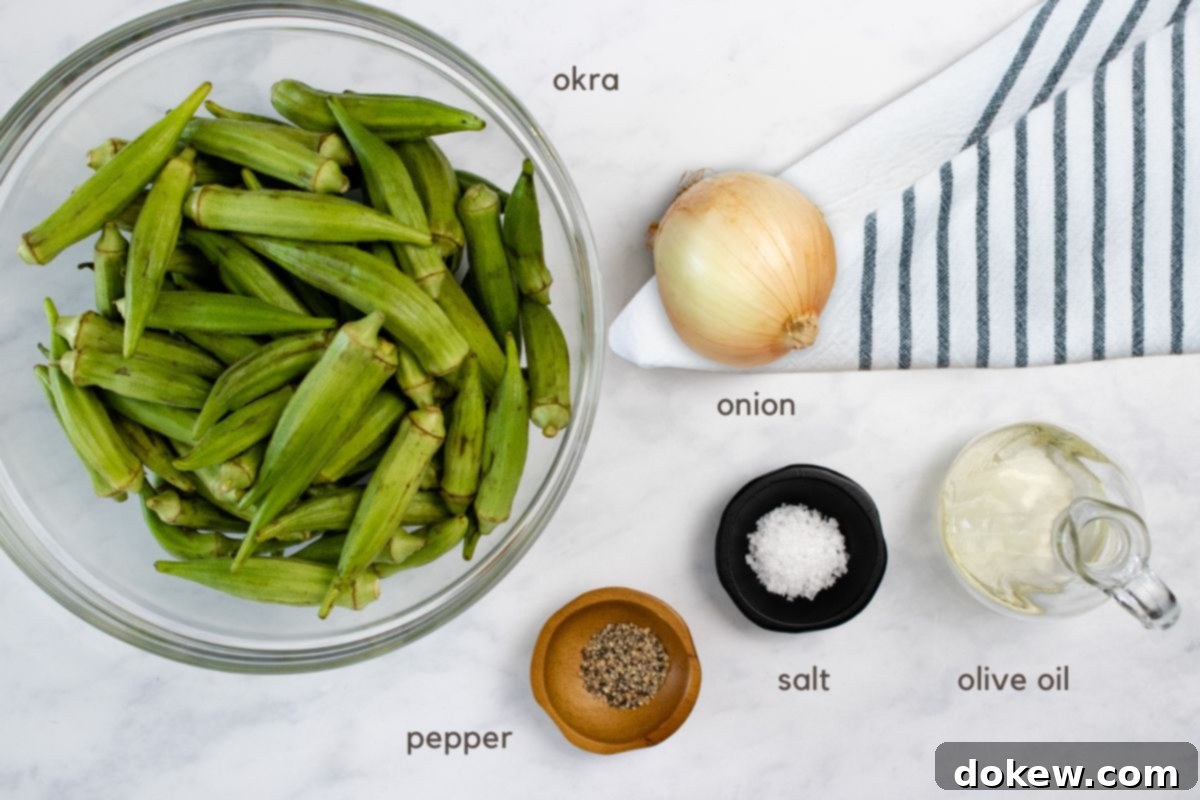
Frequently Asked Questions About Okra: Demystifying This Unique Vegetable
Okra often comes with questions, especially for those unfamiliar with its preparation. We’re here to answer your most common queries and help you unlock the delicious potential of this intriguing vegetable, particularly when it comes to roasting.
What exactly is okra, and what are its culinary origins?
Okra, often referred to as “lady’s fingers” due to its distinctive shape, is technically classified as a fruit, specifically a botanical seed pod. It belongs to the mallow family, which also includes cotton and hibiscus. Each elongated, ribbed pod is filled with numerous small, edible white seeds. Despite its botanical status, okra is almost universally used and consumed as a vegetable in cooking across various cultures. Its origins trace back to Africa, from where it spread to Asia and the Americas, becoming a cornerstone in many diverse cuisines. It’s particularly iconic in the Southern United States, the Caribbean, and parts of Africa and India, where it lends its mild, slightly grassy flavor and unique texture to dishes. In Creole and Cajun traditions, it’s a vital ingredient in dishes like gumbo, where it partners with celery, onion, and green bell pepper to form a rich and aromatic flavor base.
What is the typical cooking time for roasted okra?
The total time to bring this delicious roasted okra and onion dish to your table is remarkably brief, making it an ideal choice for any busy evening. The hands-on preparation, which involves rinsing, thoroughly drying, and precisely slicing both the okra and onions, usually takes approximately 15-20 minutes. Following this, the roasting process itself is quick and efficient, requiring about 15-20 minutes in a hot, preheated oven. It’s important to note that the exact cooking duration can fluctuate based on several variables, including the specific size of your okra pods, the thickness of your onion slices, and how evenly the vegetables are distributed on the baking sheet. For optimal results, we suggest beginning to check for doneness around the 12-minute mark. You’re looking for a tender-crisp texture with appealingly browned and caramelized edges, indicating that the natural sugars have developed beautifully and the okra is no longer slimy.
Why does okra become slimy, and how does roasting prevent it?
Okra’s well-known “sliminess” is due to mucilage, a complex carbohydrate (soluble fiber) naturally present in the pods. This mucilage is an excellent natural thickener, which is precisely why okra is a valued ingredient in many soups and stews, such as gumbo, where it helps create a rich, viscous texture. However, when preparing okra as a standalone vegetable, many prefer to minimize or eliminate this slimy quality. The great news is that roasting at high temperatures is one of the most effective culinary strategies to prevent okra from becoming slimy! The intense, dry heat of the oven breaks down the mucilage, allowing the okra to caramelize and achieve a tender, crisp-tender texture without any undesirable sliminess. Other cooking methods that effectively reduce sliminess include frying, grilling, or quickly sautéing at high heat. Conversely, methods that involve boiling or slow, moist cooking should generally be avoided if you want a non-slimy outcome, as these tend to release and activate the mucilage. Keeping a few paper towels nearby while slicing okra can be helpful to wipe off any initial sliminess from your hands and knife.
What are the best practices for roasting okra on a sheet pan?
Achieving impeccably roasted, non-slimy okra on a sheet pan hinges on a few crucial steps that maximize dry heat and minimize moisture. First and foremost, after rinsing your okra, it is absolutely vital to pat it thoroughly dry with paper towels just before you proceed with cutting. This step cannot be overstated: any residual surface moisture on the vegetables will cause them to steam rather than roast, preventing proper caramelization and increasing the likelihood of a slimy outcome. The cornerstone of delicious, non-slimy okra is the application of high, dry heat. Ensure your oven is fully preheated to the specified temperature of 400°F (200°C) before placing the vegetables inside. Line your baking sheet with parchment paper; this provides an excellent non-stick surface, promotes even roasting, and makes cleanup incredibly easy. When arranging the sliced okra and onions, it’s critical to spread them in a single layer without overcrowding the pan. Overlapping vegetables will trap moisture, leading to steaming. If necessary, use two baking sheets to give the vegetables ample space for air circulation and direct contact with the hot surface, ensuring they brown beautifully and crisp up perfectly. A light, even coating of oil and proper seasoning before roasting will further enhance these results.
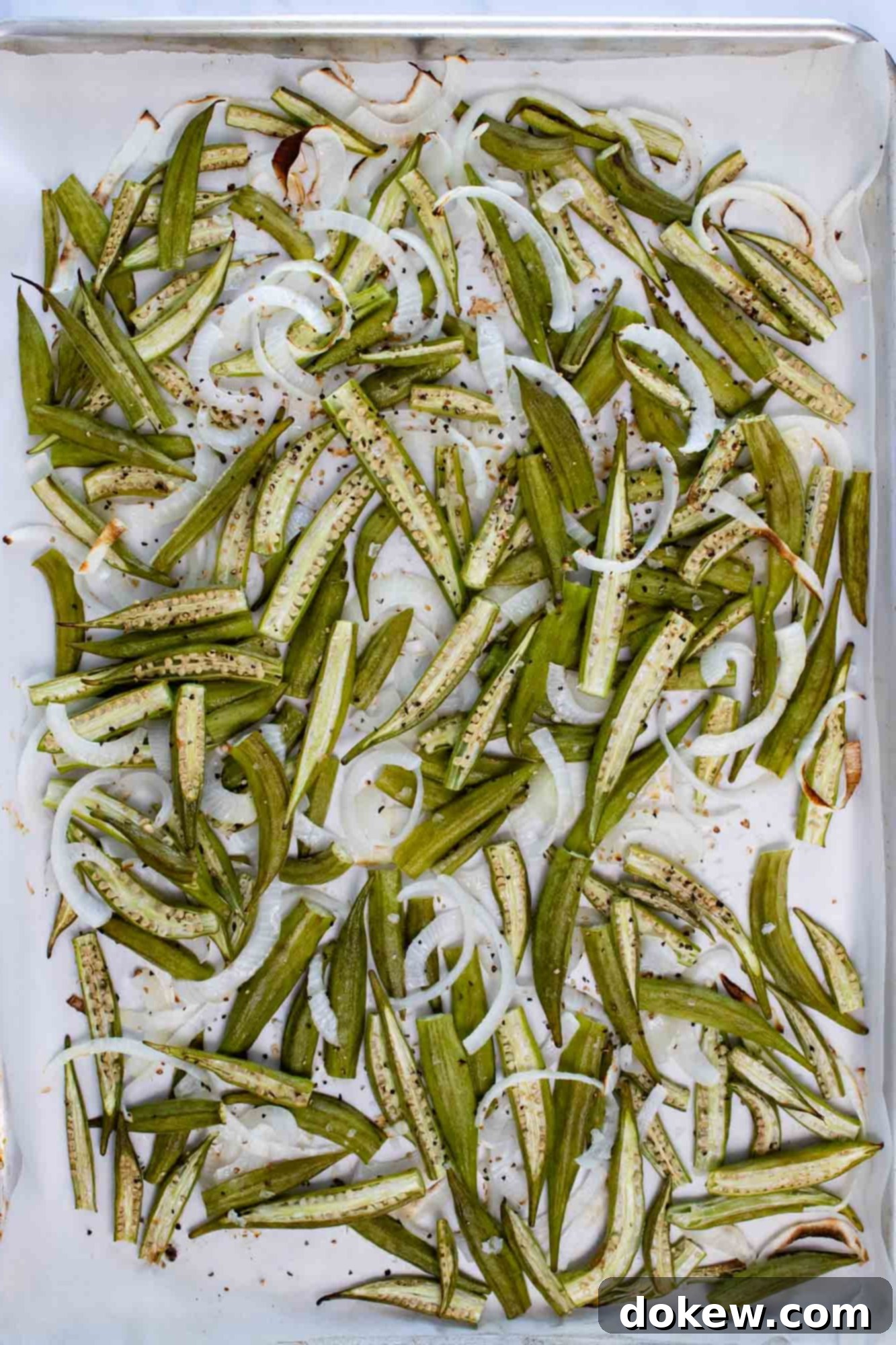
Expert Tips for Selecting the Best Okra
The foundation of a truly delicious roasted okra dish begins long before you turn on the oven – it starts with selecting the finest pods. For the most tender, sweetest, and least fibrous results, always prioritize okra that is small and slender. Larger okra pods tend to be older, tougher, and can develop an unpleasantly woody texture that will not soften adequately during roasting, failing to deliver the delightful sweet and tender outcome you desire from this recipe. When inspecting okra at the market, look for pods that are firm to the touch, possess a vibrant green color, and are free from any blemishes, soft spots, or excessive prickliness. If you are fortunate enough to shop at a farmer’s market, you might have the luxury of hand-picking individual pods. However, if purchasing prepackaged okra from a grocery store, aim for a bag where the majority of the pods are of a smaller, more uniform average size. Refer to the visual comparison below: the okra pod on the left perfectly illustrates the optimal size for roasting, while larger, thicker pods should generally be avoided for this specific preparation.
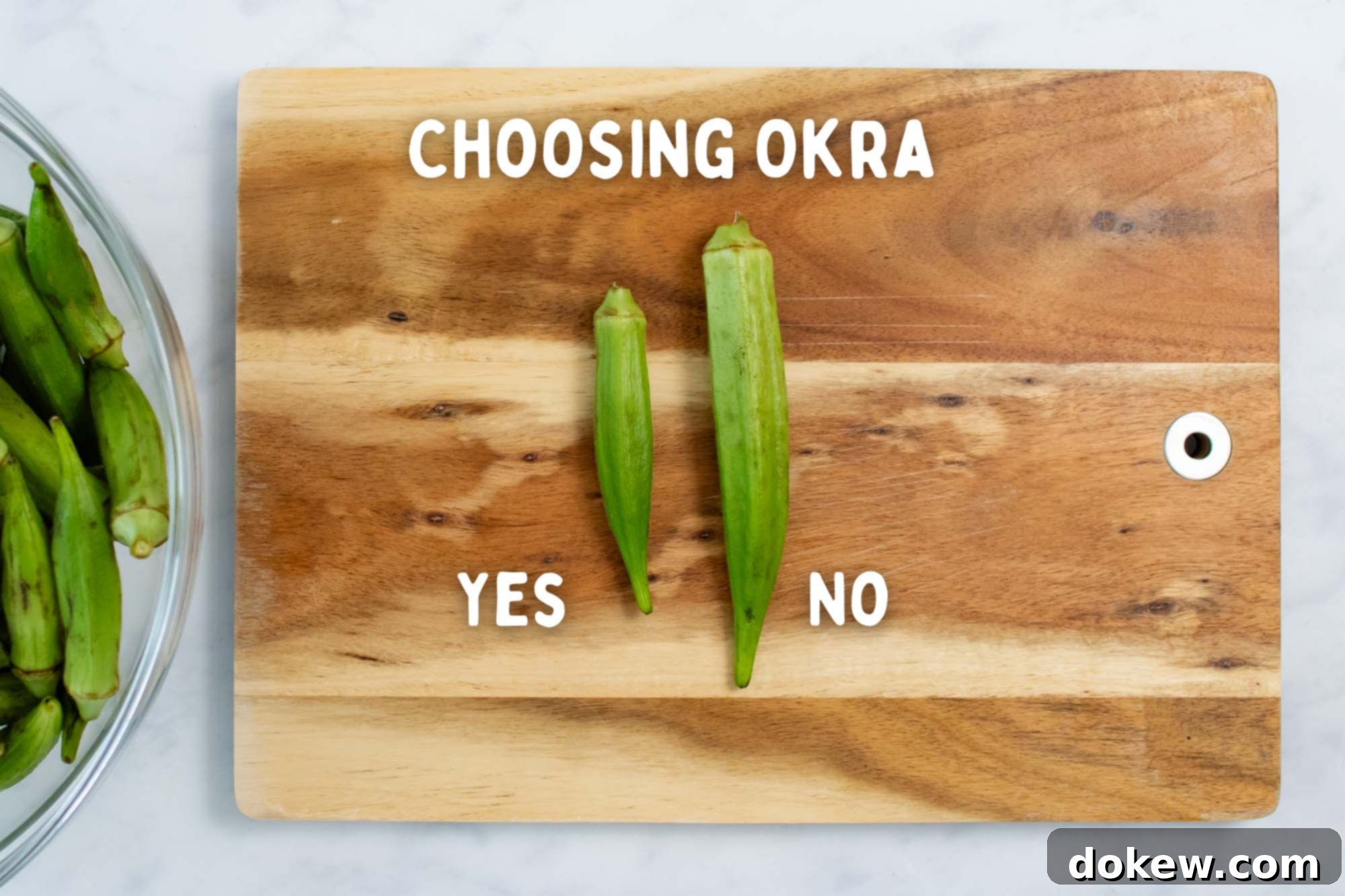
Once you’ve selected your fresh okra, proper storage is crucial to maintain its quality. As long as the okra was fresh when purchased, it can be stored unwashed in a loosely closed paper bag within the refrigerator for up to 3-4 days before you plan to cook it. It’s important to avoid storing okra in plastic bags, as these can trap moisture, accelerating spoilage and potentially encouraging sliminess even before preparation begins. Ensuring your okra is dry and stored correctly will contribute to the best possible roasted results.
The Transformative Power and Benefits of Roasting Vegetables
Roasting is undeniably one of the most beloved and effective cooking methods for an extensive range of vegetables, and for very compelling reasons. The application of high, dry heat in the oven not only cooks vegetables efficiently but also fundamentally transforms their flavor profile and textural characteristics in truly magical ways. This culinary process facilitates two crucial reactions: the Maillard reaction and caramelization. The Maillard reaction is a complex chemical process responsible for the browning and development of savory “umami” flavors, while caramelization refers to the browning of sugars, producing sweet, nutty notes. For vegetables like okra and onions, this means their inherent sweetness is brought to the forefront, intensifying and deepening to create complex, savory-sweet nuances that are challenging to replicate with other cooking techniques. The result is a wonderfully rich, slightly nutty, and often crispy exterior, contrasted with a tender, yielding interior. Furthermore, roasting typically requires far less oil compared to frying, making it a considerably healthier option. The largely hands-off nature of oven cooking is another significant advantage, freeing up your time to focus on other aspects of your meal preparation. Ultimately, roasting consistently yields deeply flavored, appealingly textured vegetables that can convert even the most skeptical eaters into fans.
Nutritional Highlights: The Health Benefits of Okra and Onions
Beyond their delightful taste and versatility in the kitchen, both okra and onions are packed with an impressive array of nutritional benefits, making this roasted dish a wonderfully healthy and conscious addition to virtually any diet.
Okra: A Green Gem of Nutrition
- Rich in Dietary Fiber: Okra is an excellent source of both soluble and insoluble dietary fiber. This fiber is vital for promoting healthy digestion, aiding in the regulation of blood sugar levels, and contributing to a sustained feeling of fullness, which can be beneficial for weight management.
- Abundant in Vitamins: It’s particularly rich in Vitamin C, a powerful antioxidant crucial for bolstering immune function and skin health, and Vitamin K, essential for blood clotting and maintaining strong bones. Okra also supplies important B vitamins, including folate, which is critical for cell growth and metabolism.
- Packed with Minerals: This green pod provides a good amount of minerals such as magnesium, manganese, and potassium, all of which play key roles in numerous bodily functions, from muscle and nerve function to maintaining fluid balance.
- Powerful Antioxidants: Okra contains various beneficial antioxidants, including polyphenols and flavonoids. These compounds help protect the body’s cells from damage caused by free radicals, potentially reducing the risk of chronic diseases and inflammation.
- Supports Heart Health: The fiber content in okra contributes to lowering LDL (“bad”) cholesterol levels, and its antioxidant profile helps protect cardiovascular health, promoting a healthier heart.
Onions: More Than Just a Flavor Enhancer
- Antioxidant Richness: Onions are exceptionally rich in antioxidants, most notably quercetin, a potent flavonoid with significant anti-inflammatory and antioxidant properties. Quercetin has been linked to numerous health benefits, including supporting heart health and potentially reducing blood pressure.
- Source of Prebiotics: They contain beneficial prebiotic fibers like fructans and inulin. These compounds act as food for the beneficial bacteria in your gut, fostering a healthy gut microbiome, which is essential for proper digestion, nutrient absorption, and overall well-being.
- Essential Vitamins and Minerals: Onions provide a good dose of Vitamin C, several B vitamins (including B6 and folate), and potassium. These nutrients are vital for immune system support, energy metabolism, red blood cell formation, and maintaining nerve function.
- Anti-inflammatory Properties: The sulfur-containing compounds and antioxidants found in onions contribute to their anti-inflammatory effects throughout the body, which may help in reducing the risk of chronic inflammatory conditions.
By thoughtfully combining these two nutritional powerhouses and preparing them through a healthy roasting method, you create a side dish that is not only incredibly flavorful and satisfying but also contributes significantly to your daily intake of essential vitamins, minerals, and protective compounds.
Flavor Variations and Inspiring Serving Suggestions
While this recipe for Roasted Okra and Onions stands out as a delicious dish on its own, its simple, caramelized base makes it an exceptional canvas for culinary creativity. Feel free to experiment with different seasonings and explore various serving ideas to perfectly tailor the dish to your taste preferences and meal plans.
Creative Flavor Boosts to Try:
- Garlic Lover’s Delight: For an aromatic kick, mince 2-3 cloves of fresh garlic and add them to the baking sheet during the last 5-7 minutes of roasting. Adding them too early risks burning the garlic, which can turn bitter.
- A Touch of Spice: If you enjoy a pleasant heat, toss a pinch of red pepper flakes or a dash of cayenne pepper with the vegetables before roasting. This adds a subtle warmth that complements the sweetness.
- Herbal Freshness: Incorporate fresh herbs like sprigs of thyme, oregano, or rosemary directly onto the baking sheet before roasting. Alternatively, for a brighter finish, sprinkle fresh chopped parsley, cilantro, or chives over the roasted vegetables just before serving.
- Bright Citrus Zest: A squeeze of fresh lemon juice or a sprinkle of finely grated lemon zest just after the vegetables come out of the oven can beautifully brighten and elevate all the flavors.
- Smoky Undertones: A tiny dash (about 1/4 teaspoon) of smoked paprika, tossed with the oil and vegetables, can impart a wonderful depth and smoky aroma, adding another layer of complexity.
- Cheesy Indulgence: For an extra layer of savory richness, sprinkle some freshly grated Parmesan cheese over the vegetables during the last 5 minutes of roasting.
Beyond a Simple Side Dish: Innovative Serving Ideas:
- Savory Breakfast Hash: Transform any leftover roasted okra and onions into a hearty and healthy breakfast hash by combining them with diced roasted potatoes and topping with a perfectly fried or poached egg.
- Wholesome Grain Bowls: Integrate these flavorful roasted vegetables into your favorite quinoa, couscous, or rice bowl. Add your preferred protein (grilled chicken, chickpeas, tofu) and a light, zesty dressing for a complete and satisfying meal.
- Dynamic Taco or Fajita Filling: Use the roasted okra and onions as a unique and delicious vegetarian filling for tacos or fajitas. Enhance the flavor profile with a touch of cumin, chili powder, and a squeeze of lime.
- Sandwich or Wrap Enhancement: They make a fantastic, healthy, and flavorful addition to cold or warm sandwiches, wraps, or even as a topping for homemade flatbreads and pizzas.
- Stir-Fry Boost: Add them to a quick stir-fry near the end of cooking for added texture and roasted flavor.
Storage and Reheating Tips for Leftovers
Making extra of this delicious roasted okra and onion dish is a great idea, as the leftovers are just as delightful with proper storage. To ensure the best quality, allow any remaining roasted vegetables to cool completely to room temperature before transferring them to an airtight container. Stored properly, they will maintain their freshness and flavor in the refrigerator for up to 3-4 days. When it comes to reheating, we strongly recommend avoiding the microwave. Microwaving can cause the okra to become overly soft and may even reactivate some of its inherent sliminess, compromising the texture you worked so hard to achieve. Instead, for optimal results, spread the cooled vegetables in a single layer on a clean baking sheet. Reheat them in a preheated oven at 350°F (175°C) for approximately 5-10 minutes, or until they are thoroughly warmed through and have regained a slight crispness around the edges. This method helps to preserve their lovely texture and caramelized flavor, making your leftovers just as enjoyable as the freshly cooked dish.
Recipe Card: Delicious Roasted Okra and Onions
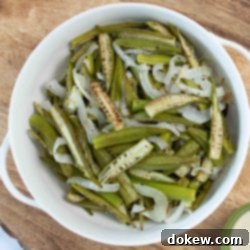
Delicious Roasted Okra and Onions
Add to Shopping ListGo to Shopping List
Equipment
-
Parchment Paper – Essential for a non-stick surface, ensuring easy vegetable release and unbelievably simple cleanup. No more scrubbing burnt bits from your pan!
-
15×21 Baking Sheet Pan – A large, sturdy baking sheet is crucial to provide ample space for the okra and onions to spread out in a single layer. This prevents overcrowding, which is key for proper roasting and caramelization instead of steaming.
Ingredients
- 2 pounds fresh okra, preferably small and tender pods for best flavor and texture
- 1 large yellow onion, peeled and thinly sliced into half-moons for even cooking and caramelization
- Salt and freshly ground black pepper, to taste (we recommend starting with 1/2 tsp salt and 1/4 tsp pepper, then adjusting after roasting)
- 2 tablespoons vegetable oil, or olive oil for a richer, Mediterranean flavor profile
Instructions
-
Prepare Oven and Pan: Begin by preheating your oven to a high temperature of 400ºF (200ºC). While the oven preheats, line a large 15×21 baking sheet pan with parchment paper. This critical step ensures a non-stick surface, promotes even roasting, and guarantees remarkably easy cleanup afterward.
-
Wash and Thoroughly Dry Okra: Rinse the fresh okra pods under cold, running water. Immediately after rinsing, it is absolutely essential to pat them thoroughly dry with clean paper towels. Any residual moisture on the okra can lead to steaming rather than true roasting, which will hinder caramelization and potentially reintroduce sliminess.
-
Precisely Slice Okra and Onion: Carefully cut off and discard the tough, woody stem end from each okra pod. Then, slice each okra pod in half lengthwise. Next, peel the large yellow onion and slice it into thin, uniform half-moons, ensuring consistent cooking.
-
Combine and Coat with Oil: Place the prepared, sliced onion and okra halves onto the parchment paper-lined baking pan. Evenly drizzle the 2 tablespoons of vegetable oil (or olive oil) over all the vegetables, ensuring every piece gets coated.
-
Toss and Arrange Evenly: Using your hands or a spatula, gently toss and mix the vegetables directly on the baking sheet until all pieces are lightly and uniformly coated in the oil. Then, arrange them in a single, even layer across the entire parchment paper surface. This step is crucial: ensure there is enough space between the pieces and they do not overlap. If your pan is overcrowded, use a second baking sheet to prevent steaming and encourage proper browning.
-
Season Generously: Generously sprinkle the oiled and arranged vegetables with salt and freshly ground black pepper to taste. This is also the stage where you can add any additional desired seasonings, such as garlic powder, smoked paprika, or a pinch of red pepper flakes for extra flavor.
-
Roast to Golden Perfection: Place the baking sheet into the preheated oven and roast for approximately 15-20 minutes. Begin checking for doneness around the 12-minute mark. The precise cooking time may vary based on the size of your okra, the thickness of your onions, and oven efficiency. You’re looking for vegetables that are tender when pierced with a fork but still possess a slight bite, with beautifully browned and caramelized edges. They should appear golden and slightly crisp, not mushy or overly soft. Serve immediately and savor your perfectly roasted, sweet, and savory side dish!
Nutrition per serving
Share
Pin
